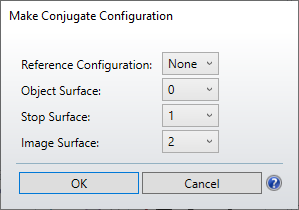Make Conjugate

Create a subset of the optical system which models imaging between any two conjugate surfaces as a new configuration. This feature is useful for evaluating or optimizing the performance of the optical system between any two surfaces of the design.

This tool will create a subset of the optical system which models imaging between any two conjugate surfaces as a new configuration. This feature is useful for evaluating or optimizing the performance of the optical system in between two surfaces which are not always the object and image surfaces. The subset system is defined by the object, stop, and image surface numbers as defined in a reference configuration. If no multi-configuration data exists, then two configurations, the nominal and subset configurations, will be created. If multi-configuration data already exists, then any configuration, or all configurations, may be used as the reference configuration(s). If a single reference configuration is selected, then one new configuration will be added. If all configurations are selected, then the total number of configurations will double, as one subset configuration will be created for each existing configuration.
The subset configurations are created by adding as required multi-configuration operands to alter the system aperture type, size, stop location, field data, thicknesses, curvatures, aspheric data, and other data as appropriate. The ignore surface feature (See "Ignore This Surface") is used to eliminate surfaces not relevant to the subset configuration. This feature makes the following assumptions about how to construct the subset system:
The system aperture is set to "float by stop size" and the semi-diameter of the new stop is set to the currentsemi-diameter of the surface in the reference configuration.
The field type is set to object height, and the field values are set to the primary wavelength chief ray coordinates on the specified object surface in the reference configuration.
The original object and image surfaces in the reference configuration are placed under the control of multi-configuration operands to allow those surfaces to take on the correct shape of the subset object and image surfaces. For this reason, currently the original and subset object and image surfaces must all be Standard surface types.
These assumptions may not be correct in all cases. The resulting subset conjugate system should be carefully checked for validity.
Next:


